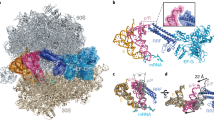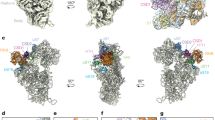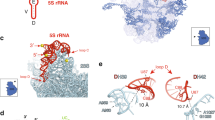Abstract
Peptide bond formation is the principal reaction of protein synthesis. It takes place in the peptidyl transferase centre of the large (50S) ribosomal subunit. In the course of the reaction, the polypeptide is transferred from peptidyl transfer RNA to the α-amino group of amino acyl-tRNA. The crystallographic structure of the 50S subunit showed no proteins within 18 Å from the active site, revealing peptidyl transferase as an RNA enzyme1. Reported unique structural and biochemical features of the universally conserved adenine residue A2451 in 23S ribosomal RNA (Escherichia coli numbering) led to the proposal of a mechanism of rRNA catalysis that implicates this nucleotide as the principal catalytic residue2,3. In vitro genetics allowed us to test the importance of A2451 for the overall rate of peptide bond formation. Here we report that large ribosomal subunits with mutated A2451 showed significant peptidyl transferase activity in several independent assays. Mutations at another nucleotide, G2447, which is essential to render catalytic properties to A2451 (refs 2, 3), also did not dramatically change the transpeptidation activity. As alterations of the putative catalytic residues do not severely affect the rate of peptidyl transfer the ribosome apparently promotes transpeptidation not through chemical catalysis, but by properly positioning the substrates of protein synthesis.
This is a preview of subscription content, access via your institution
Access options
Subscribe to this journal
Receive 51 print issues and online access
$199.00 per year
only $3.90 per issue
Buy this article
- Purchase on Springer Link
- Instant access to full article PDF
Prices may be subject to local taxes which are calculated during checkout



Similar content being viewed by others
References
Ban, N., Nissen, P., Hansen, J., Moore, P. B. & Steitz, T. A. The complete atomic structure of the large ribosomal subunit at 2.4 Å resolution. Science 289, 905–920 (2000).
Nissen, P., Hansen, J., Ban, N., Moore, P. B. & Steitz, T. A. The structural basis of ribosome activity in peptide bond synthesis. Science 289, 920–930 (2000).
Muth, G. W., Ortoleva-Donnelly, L. & Strobel, S. A. A single adenosine with a neutral pKa in the ribosomal peptidyl transferase center. Science 289, 947–950 (2000).
Moazed, D. & Noller, H. F. Interaction of tRNA with 23S rRNA in the ribosomal A, P, and E sites. Cell 57, 585–597 (1989).
Bocchetta, M., Xiong, L. & Mankin, A. S. 23S rRNA positions essential for tRNA binding in ribosomal functional sites. Proc. Natl Acad. Sci. USA 95, 3525–3530 (1998).
Steiner, G., Kuechler, E. & Barta, A. Photo-affinity labelling at the peptidyl transferase centre reveals two different positions for the A- and P-sites in domain V of 23S rRNA. EMBO J. 7, 3949–3955 (1988).
Kearsey, S. E. & Craig, I. W. Altered ribosomal RNA genes in mitochondria from mammalian cells with chloramphenicol resistance. Nature 290, 607–608 (1981).
Barta, A. et al. Mechanism of ribosomal peptide bond formation. Science 291, 203a (2001) (on-line).
Khaitovich, P., Tenson, T., Kloss, P. & Mankin, A. S. Reconstitution of functionally active Thermus aquaticus large ribosomal subunits with in vitro-transcribed rRNA. Biochemistry 38, 1780–1788 (1999).
Monro, R. E. & Marcker, K. A. Ribosome-catalysed reaction of puromycin with a formylmethionine-containing oligonucleotide. J. Mol. Biol. 25, 347–350 (1967).
Hart, H. E. & Greenwald, E. B. Scintillation proximity assay (SPA)—a new method of immunoassay. Direct and inhibition mode detection with human albumin and rabbit antihuman albumin. Mol. Immunol. 16, 265–267 (1979).
Swaney, S. M. et al. in Abstracts of the 38th Interscience Conference on Antimicrobial Agents and Chemotherapy C-104 (American Society for Microbiology, Washington DC, 1998).
Xiong, L. Q. et al. Oxazolidinone resistance mutations in 23S rRNA of Escherichia coli reveal the central region of domain V as the primary site of drug action. J. Bacteriol. 182, 5325–5331 (2000).
Green, R. & Noller, H. F. Reconstitution of functional 50S ribosomes from in vitro transcripts of Bacillus stearothermophilus 23S rRNA. Biochemistry 38, 1772–1779 (1999).
Green, R., Samaha, R. R. & Noller, H. F. Mutations at nucleotides G2251 and U2585 of 23 S rRNA perturb the peptidyl transferase center of the ribosome. J. Mol. Biol. 266, 40–50 (1997).
Porse, B. T. & Garrett, R. A. Mapping important nucleotides in the peptidyl transferase centre of 23 S rRNA using a random mutagenesis approach. J. Mol. Biol. 249, 1–10 (1995).
O'Connor, M. & Dahlberg, A. E. Mutations at U2555, a tRNA-protected base in 23S rRNA, affect translational fidelity. Proc. Natl Acad. Sci. USA 90, 9214–9218 (1993).
Nakano, S., Chadalavada, D. M. & Bevilacqua, P. C. General acid-base catalysis in the mechanism of a hepatitis delta virus ribozyme. Science 287, 1493–1497 (2001).
Yean, S. L., Wuenschell, G., Termini, J. & Lin, R. J. Metal-ion coordination by U6 small nuclear RNA contributes to catalysis in the spliceosome. Nature 408, 881–884 (2001).
Krayevsky, A. A. & Kukhanova, M. K. The peptidyltransferase center of ribosomes. Prog. Nucl. Acid Res. Mol. Biol. 23, 1–51 (1979).
Nierhaus, K. H., Schulze, H. & Cooperman, B. S. Molecular mechanisms of the ribosomal peptidyl transferase center. Biochem. Int. 1, 185–192 (1980).
Samaha, R. R., Green, R. & Noller, H. F. A base pair between tRNA and 23S rRNA in the peptidyl transferase centre of the ribosome. Nature 377, 309–314 (1995).
Khaitovich, P., Tenson, T., Mankin, A. S. & Green, R. Peptidyl transferase activity catalyzed by protein-free 23S ribosomal RNA remains elusive. RNA 5, 605–608 (1999).
Zhang, B. & Cech, T. R. Peptide bond formation by in vitro selected ribozymes. Nature 390, 96–100 (1997).
Crick, F. H. C., Brenner, S., Klug, A. & Pieczenik, G. A speculation on the origin of protein synthesis. Orig. Life. 7, 389–397 (1976).
Khaitovich, P. & Mankin, A. S. in The Ribosome. Structure, Function, Antibiotics and Cellular Interactions (eds Garrett, R. A. et al.) 229–243 (ASM, Washington DC, 2000).
Green, R. & Noller, H. F. In vitro complementation analysis localizes 23S rRNA posttranscriptional modifications that are required for Escherichia coli 50S ribosomal subunit assembly and function. RNA 2, 1011–1021 (1996).
Blaha, G. et al. Preparation of functional ribosomal complexes and effect of buffer conditions on tRNA positions observed by cryoelectron microscopy. Methods Enzymol. 317, 292–309 (2000).
Kim, D. F. & Green, R. Base-pairing between 23S rRNA and tRNA in the ribosomal A site. Mol. Cell 4, 859–864 (1999).
Nierhaus, K. H. in Ribosomes and Protein Synthesis. A Practical Approach (ed. Spedding, G.) 161–189 (Oxford Univ. Press, Oxford, 1990).
Acknowledgements
We thank M. Gomez and L. Xiong for help with experiments; S. Swaney and D. Shinabarger for providing SPA assay protocols and reagents; and J. Piccirilli, A. Mesecar and A. Neyfakh for helpful discussions. This work was supported by an NIH grant to A.S.M. N.P. was supported by an Erwin Schroedinger fellowship from the Austrian Science Foundation.
Author information
Authors and Affiliations
Corresponding author
Rights and permissions
About this article
Cite this article
Polacek, N., Gaynor, M., Yassin, A. et al. Ribosomal peptidyl transferase can withstand mutations at the putative catalytic nucleotide. Nature 411, 498–501 (2001). https://doi.org/10.1038/35078113
Received:
Accepted:
Issue Date:
DOI: https://doi.org/10.1038/35078113
This article is cited by
-
Molecular basis for erythromycin-dependent ribosome stalling during translation of the ErmBL leader peptide
Nature Communications (2014)
-
The 2′-OH group of the peptidyl-tRNA stabilizes an active conformation of the ribosomal PTC
The EMBO Journal (2011)
-
Ribosome evolution: Emergence of peptide synthesis machinery
Journal of Biosciences (2011)
-
What recent ribosome structures have revealed about the mechanism of translation
Nature (2009)
-
Rapid peptide bond formation on isolated 50S ribosomal subunits
EMBO reports (2006)
Comments
By submitting a comment you agree to abide by our Terms and Community Guidelines. If you find something abusive or that does not comply with our terms or guidelines please flag it as inappropriate.



